Thousands of foreign tourists will visit the Montenegrin Coast this summer. They come to enjoy the sun and the sea, but I am sure that many of them will also be interested in visiting cultural monuments. Apart from beautiful old towns along the Adriatic Sea, they can find more than a dozen Orthodox monasteries along the coastal strip between Petrovac and Herceg Novi, which is quite a memorable fact. What makes the Orthodox monasteries on the coast so beautiful? First of all, the frescoes, not only the medieval ones but also paintings from more recent times. I like the mystic atmosphere of the churches, the simple architecture and the silence in the beautiful courtyards and gardens. Their spectacular terraces offer a fantastic view over the Adriatic. In my opinion, five of these monasteries have “something special” – this is my choice:
- Reževići Monastery: turbulent history and beautiful position
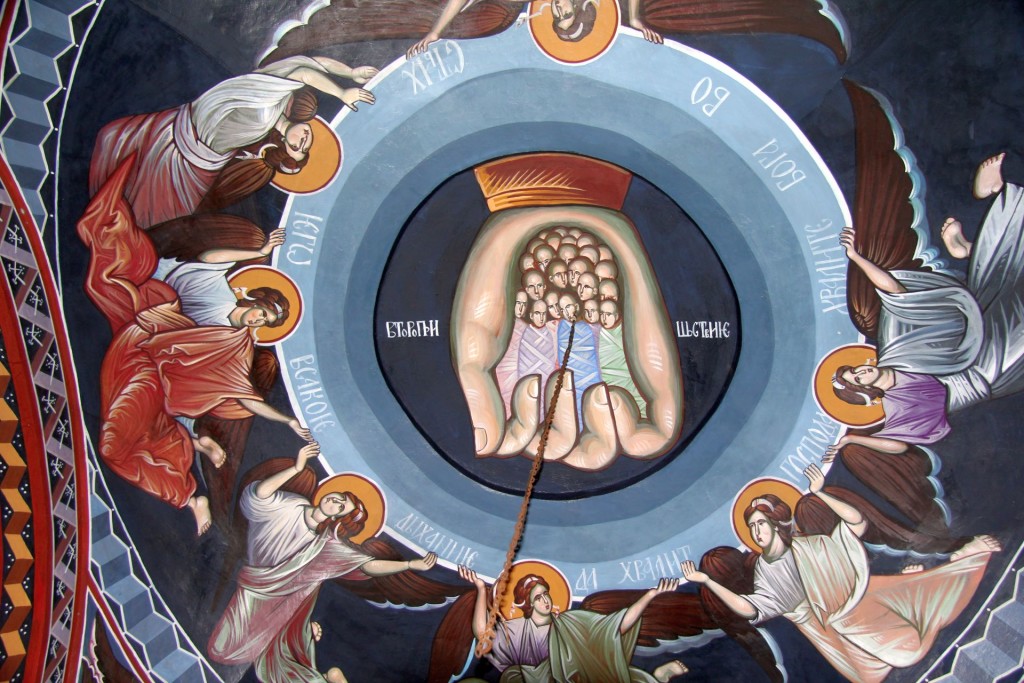 You will see this monastery complex along the road when driving from Budva to Petrovac. There is a legend from 1226, which says that the Serbian king Stefan the First-Crowned built a church here, when he got drunk from the local wine traveling through the area of the Paštrovići clan. The old fresco paintings in the small church of the Assumption of the Holy Mother of God suggest that he was also buried here. But I also like the more recent frescoes in the larger Church of the Holy Trinity, built in the 18th century. The monastery has always demonstrated traditional hospitality, as a written record testifies that a jug of wine could always be found here for travelers passing by. The view over the Adriatic Sea from the terrace is magnificent!
You will see this monastery complex along the road when driving from Budva to Petrovac. There is a legend from 1226, which says that the Serbian king Stefan the First-Crowned built a church here, when he got drunk from the local wine traveling through the area of the Paštrovići clan. The old fresco paintings in the small church of the Assumption of the Holy Mother of God suggest that he was also buried here. But I also like the more recent frescoes in the larger Church of the Holy Trinity, built in the 18th century. The monastery has always demonstrated traditional hospitality, as a written record testifies that a jug of wine could always be found here for travelers passing by. The view over the Adriatic Sea from the terrace is magnificent!
- Praskvica Monastery: the starting point of Jegor’s path
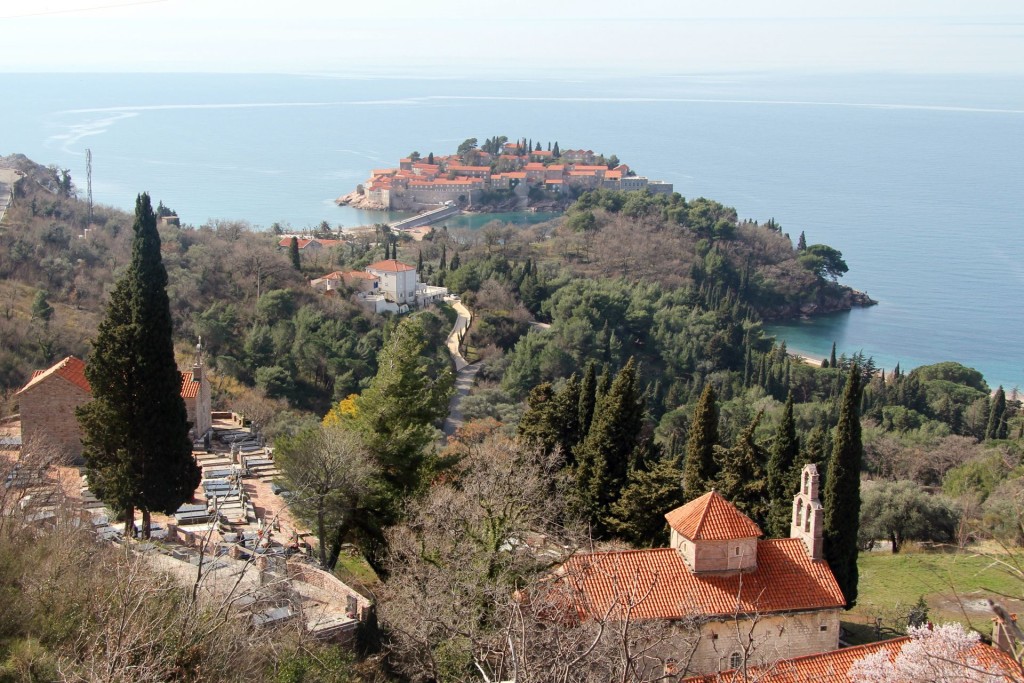 Praskvica is situated just above Sveti Stefan and has always been very important as a spiritual and political center of the Paštrovići clan. It was probably founded in the 11th century and got its name after the nearby spring, whose water smells of peaches, called “praske” by the locals. The churches are certainly worth a visit, but the Praskvica Monastery is especially interesting as the starting point of Jegor’s path. This path that leads from the monastery to the village of Ćelobrdo was built in the beginning of the 19th century by the one-armed Russian friar Jegor Stroganov. Can you imagine that he managed to build a 3 km long footpath by picking stones with only one hand and a hammer? From the top of the path you can enjoy a stunning view of Sveti Stefan and its surroundings.
Praskvica is situated just above Sveti Stefan and has always been very important as a spiritual and political center of the Paštrovići clan. It was probably founded in the 11th century and got its name after the nearby spring, whose water smells of peaches, called “praske” by the locals. The churches are certainly worth a visit, but the Praskvica Monastery is especially interesting as the starting point of Jegor’s path. This path that leads from the monastery to the village of Ćelobrdo was built in the beginning of the 19th century by the one-armed Russian friar Jegor Stroganov. Can you imagine that he managed to build a 3 km long footpath by picking stones with only one hand and a hammer? From the top of the path you can enjoy a stunning view of Sveti Stefan and its surroundings.
- Rustovo Monastery: a beautiful forest setting
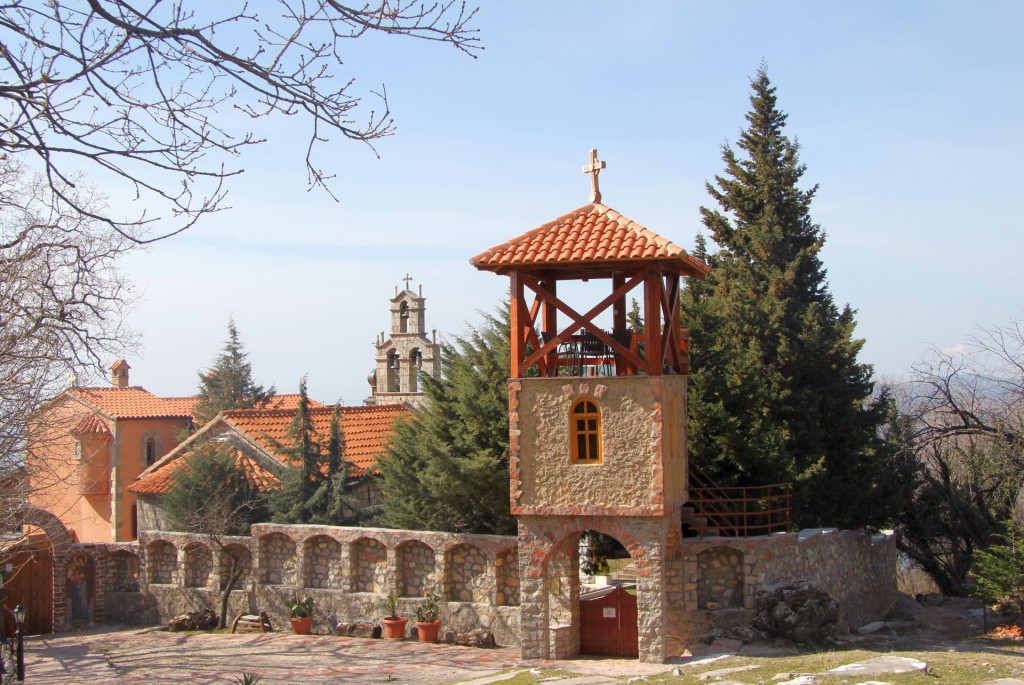 Rustovo is located around 3 km above the Praskvica Monastery, deep in the forest. It is dedicated to the Assumption of the Holy Mother of God and it has been a convent since 2004. Within the monastery complex, there is a little chapel with magnificent icons, dedicated to St. Benedict of Nursia, as well as a more recent wooden church in Russian style, dedicated to the Romanov family. The 17 nuns in this monastery are always busy with weaving, embroidery and collecting herbs for making various cosmetic and medicinal products.
Rustovo is located around 3 km above the Praskvica Monastery, deep in the forest. It is dedicated to the Assumption of the Holy Mother of God and it has been a convent since 2004. Within the monastery complex, there is a little chapel with magnificent icons, dedicated to St. Benedict of Nursia, as well as a more recent wooden church in Russian style, dedicated to the Romanov family. The 17 nuns in this monastery are always busy with weaving, embroidery and collecting herbs for making various cosmetic and medicinal products.
- Podmaine Monastery: cruel frescoes and an interesting story
This monastery was built in the 15th century and looks like a fortress. It is told that the 19th century Montenegrin prince-bishop and writer Petar Petrović Njegoš wrote a large part of his work “Gorski Vijenac” (Mountain Wreath) on the monastery’s terrace overlooking the Adriatic Sea.
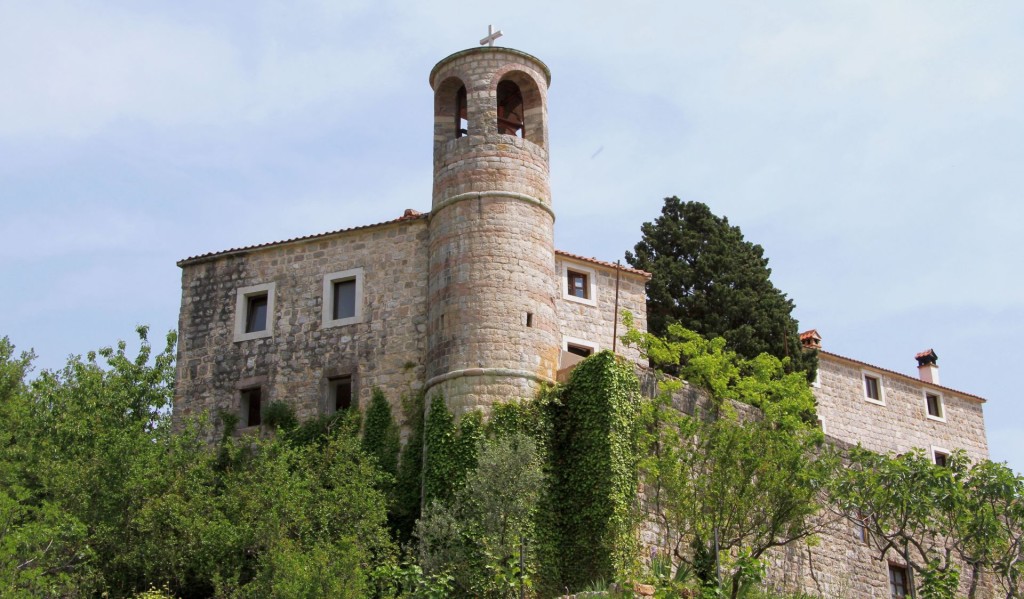 I was really stunned when I saw the new frescoes in the smaller church (painted in 2002). According to some views, one of these frescoes, titled Sinful bishops and emperors, presents Tito and the heads of the uncanonical Montenegrin Orthodox Church with ropes around their necks, while little devils with horns and a long tail are pulling them down into the fire of hell. But also other frescoes act as a deterrent. Big fishes are eating parts of human bodies and even a complete man. What a fantasy of violence! (see: Budva: The frescoes of monastery Podmaine)
I was really stunned when I saw the new frescoes in the smaller church (painted in 2002). According to some views, one of these frescoes, titled Sinful bishops and emperors, presents Tito and the heads of the uncanonical Montenegrin Orthodox Church with ropes around their necks, while little devils with horns and a long tail are pulling them down into the fire of hell. But also other frescoes act as a deterrent. Big fishes are eating parts of human bodies and even a complete man. What a fantasy of violence! (see: Budva: The frescoes of monastery Podmaine)
- Savina Monastery: Baroque architecture and a magnificent panorama
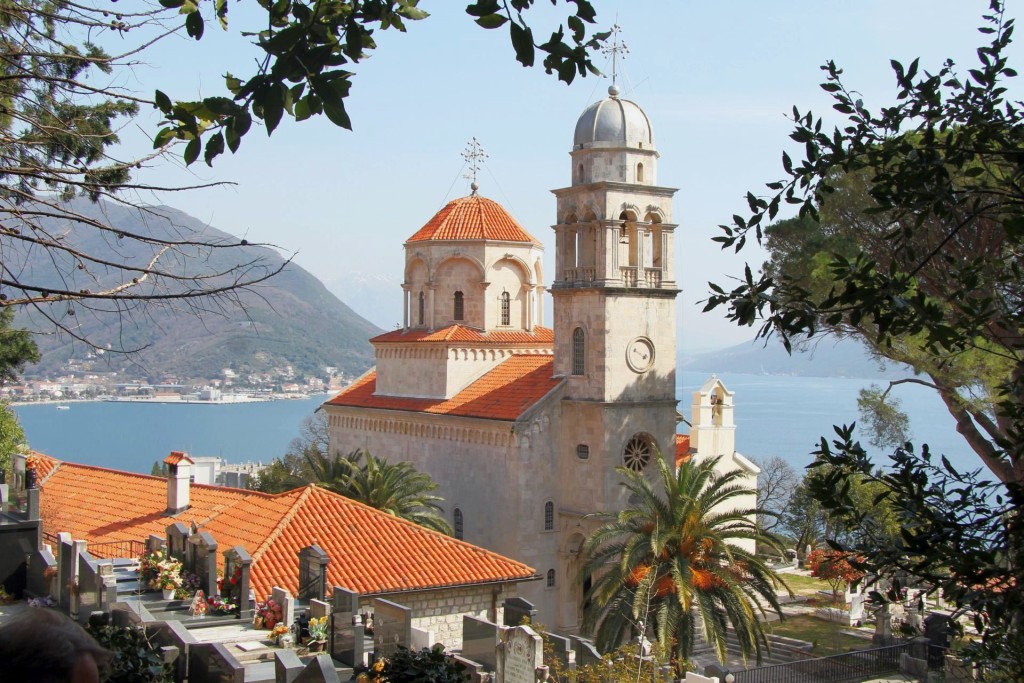 This monastery is located 2 km away from Herceg Novi in a dense Mediterranean forest. It is situated on a hill with a magnificent view over Luštica and Oštri Rt, but also towards Tivat and Mount Lovćen. It is one of the finest examples of Baroque architecture in the Adriatic and consists of three churches and sleeping quarters. The oldest church dates back to the year 1030, while the church of St. Sava, with superb frescoes, was built in the 13th century on a nearby hill. When I visited the monastery, I was particularly impressed by the peaceful atmosphere in the courtyard of the complex, surrounded by high palms and other trees.
This monastery is located 2 km away from Herceg Novi in a dense Mediterranean forest. It is situated on a hill with a magnificent view over Luštica and Oštri Rt, but also towards Tivat and Mount Lovćen. It is one of the finest examples of Baroque architecture in the Adriatic and consists of three churches and sleeping quarters. The oldest church dates back to the year 1030, while the church of St. Sava, with superb frescoes, was built in the 13th century on a nearby hill. When I visited the monastery, I was particularly impressed by the peaceful atmosphere in the courtyard of the complex, surrounded by high palms and other trees.
I hope I have convinced you to visit these gorgeous monasteries during your holiday on the Montenegrin Coast. They are just a part of the cultural wealth Montenegro has to offer.
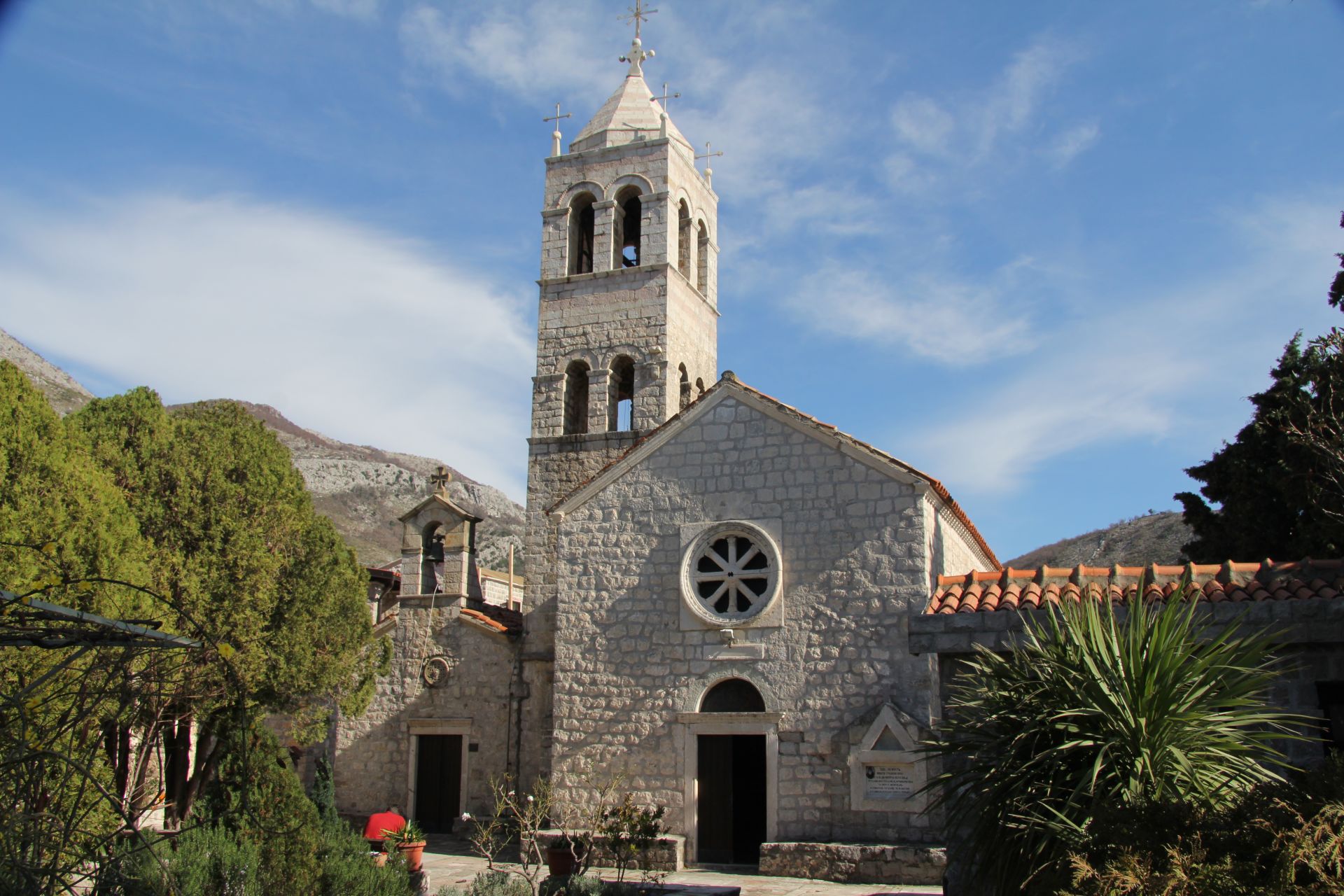
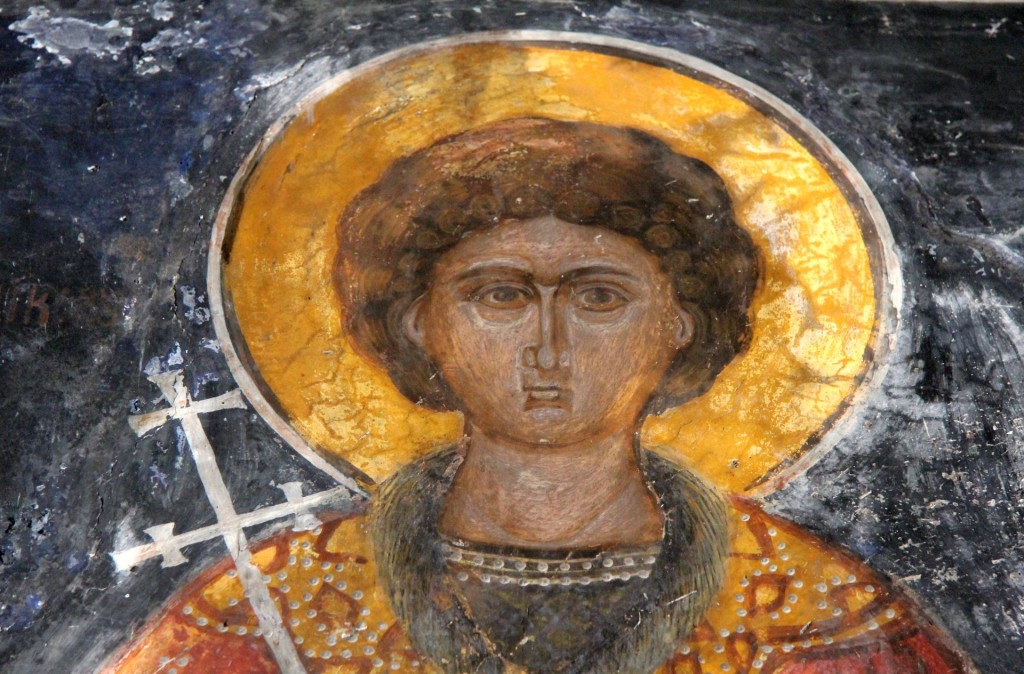
[…] https://montenegro-for.me/2016/02/5-beautiful-monasteries-on-the-montenegrin-coast/ […]
Thank you for this fantastic information! Do you have any idea how I would contact any of these monasteries for a visit? Are they nuns or monks? The Savina Monastery near Herceg Novi particularly fascinates me. Did you get stay or see any of their services? Or were you just looking around the outside by yourself?
Just google them, you will find a lot of additional information!
[…] the last few years, I have visited many Orthodox monasteries all over Montenegro. One of the few monasteries I had not visited yet was Stanjevići monastery, […]